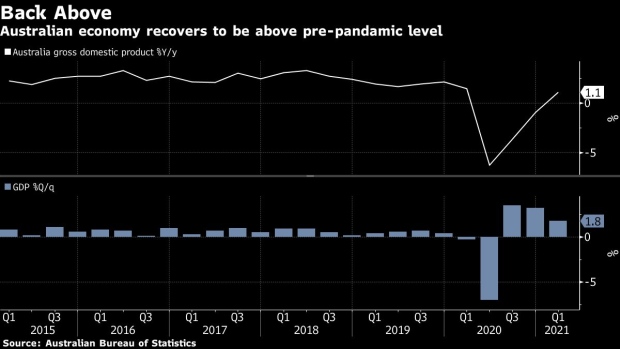Jun 1, 2021
Australia’s GDP Exceeds Estimates, Recouping Pandemic Losses
, Bloomberg News

(Bloomberg) -- Australia’s economy expanded faster than economists forecast in the first three months of the year as households tapped some of their savings and businesses boosted investment.
Gross domestic product advanced 1.8% from the final quarter of 2020, when it rose a revised 3.2%, the Australian Bureau of Statistics said in Sydney Wednesday. Economists had forecast a first-quarter gain of 1.5%. From a year earlier, the economy expanded 1.1 % vs an estimated 0.6% increase.
“The economic recovery in Australia is stronger than earlier expected and is forecast to continue,” Reserve Bank of Australia Governor Philip Lowe said Tuesday after keeping stimulatory policy settings in place. It’s being supported by “fiscal measures and very accommodative financial conditions,” he said.
Australia’s rapid rebound has been underpinned by its ability to limit Covid-19 to isolated flare ups, boosting consumer and business confidence. A massive fiscal-monetary injection strengthened the financial position of households and firms during the lockdown, and consumers are now spending savings built up.
“Australian economic activity has recovered to be above pre-pandemic levels,” Michael Smedes, head of National Accounts at the ABS, said in a statement. “Machinery and equipment investment recorded its strongest quarterly rise since December 2009, driven by the continued improvement in business confidence and support from government tax incentives.”
The Australian dollar was little changed after the release, trading at 77.68 U.S. cents at 11:50 a.m. in Sydney.
Today’s report showed:
- Household spending rose 1.2%, adding 0.7 percentage point to GDP; while government consumption slid 0.5%, cutting 0.1 percentage point
- Private investment advanced 5.3%, adding 0.9 percentage point and dwelling investment increased 6.4%
- Among the declines were non-dwelling construction, falling 1.1% and cutting 0.1 percentage point from GDP; net exports shaved 0.6 percentage point from GDP
- The savings rate slid to 11.6% in the first quarter from an upwardly revised 12.2% in the fourth quarter of 2020
Unemployment in Australia has steadily declined as the recovery gathered pace, reaching 5.5% in April from a pandemic peak of 7.4%.
Some pandemic support has now been withdrawn, such as loan repayment deferrals and the government’s JobKeeper wage subsidy that expired just before the end of the first quarter. Treasury Secretary Steven Kennedy said in testimony Tuesday that partial data showed around 56,000 workers had lost their jobs in the four weeks following the conclusion of JobKeeper on March 28.
A potential risk to the outlook is Australia’s sluggish rollout of a Covid vaccine, which has been heightened by a renewed outbreak of the virus in Melbourne that prompted a weeklong lockdown in the nation’s second-largest city.
“An important ongoing source of uncertainty is the possibility of significant outbreaks of the virus, although this should diminish as more of the population is vaccinated,” Lowe said yesterday.
Australia’s government and central bank have worked closely to support the economy through the pandemic. Treasurer Josh Frydenberg unveiled further stimulus measures in his May budget, joining forces with Lowe in trying to push the economy to maximum employment and revive sluggish inflation.
The central bank is due to decide next month on rolling over its yield target to a later maturity and whether to extend its quantitative easing program.
(Updates with details of report throughout)
©2021 Bloomberg L.P.